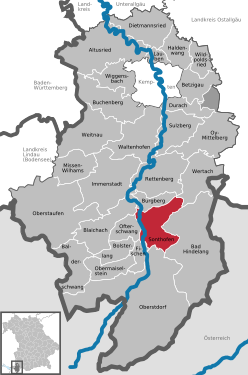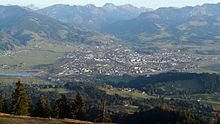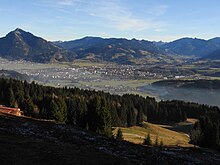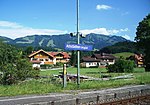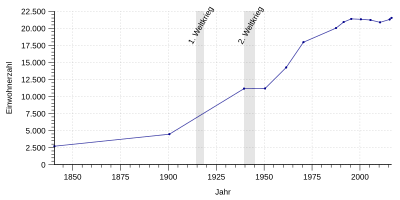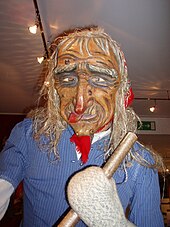Sonthofen
| coat of arms | Germany map | |
|---|---|---|
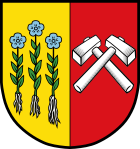
|
Coordinates: 47 ° 31 ' N , 10 ° 17' E |
|
| Basic data | ||
| State : | Bavaria | |
| Administrative region : | Swabia | |
| County : | Oberallgäu | |
| Height : | 741 m above sea level NHN | |
| Area : | 46.6 km 2 | |
| Residents: | 21,619 (Dec. 31, 2019) | |
| Population density : | 464 inhabitants per km 2 | |
| Postal code : | 87527 | |
| Area code : | 08321 | |
| License plate : | OA | |
| Community key : | 09 7 80 139 | |
| City structure: | 19 parts of the community | |
City administration address : |
Rathausplatz 1 87527 Sonthofen |
|
| Website : | ||
| Mayor : | Christian Wilhelm ( Free Voters ) | |
| Location of the city of Sonthofen in the Oberallgäu district | ||
Sonthofen is the district town of the Swabian district of Oberallgäu in Bavaria . It was named Alpine City of the Year 2005.
geography
location
The urban area of Sonthofen lies in an area of about 750 to 1100 meters above sea level on the northern edge of the Allgäu Alps . The rivers Iller and Ostrach flow through the city . Sonthofen is about 40 kilometers from Lake Constance and 120 kilometers from Munich and the southernmost city in Germany. After the incorporation in 1976, the Grünten borders on the municipality of Sonthofen.
City structure
Sonthofen has 19 officially named parts of the municipality (the type of settlement is given in brackets ):
|
|
City view from noon
history
Until the church is planted
At the foot of the Calvary there was presumably an Alemannic settlement with which the local history began. One suspects an old thing site on the hilltop . A compulsory trial was held here every year from 1120 onwards. Before 1800 Sonthofen was a nursing office and belonged to the Augsburg bishopric . With the Reichsdeputationshauptschluss of 1803, the place came to Bavaria. Sonthofen had market rights with important proprietary rights since 1429. In the course of the administrative reforms in Bavaria , today's municipality was created with the municipal edict of 1818 .
20th century
Sonthofen received supraregional importance during the National Socialist era through the stationing of the Wehrmacht and SS units.
The Ordensburg , built in 1935, served the NSDAP as the Adolf Hitler School . After the war it was first used by the US armed forces and taken over by the Bundeswehr in 1956 and renamed Generaloberst-Beck-Kaserne .
Sonthofen was bombed twice during World War II: the first time on February 22, 1945; the cheese warehouse, the hospital church and the cooperative bank were hit. The second attack took place on April 29, 1945; the Catholic parish church of St. Michael was hit.
On August 18, 1963, Sonthofen was named "City".
Incorporations
On January 1, 1976, as part of the regional reform in Bavaria, the previously independent municipality of Altstädten with Hinang, Beilenberg and Hochweiler was incorporated.
Population development
Between 1988 and 2018, the city grew from 20,037 to 21,541 by 1,504 inhabitants or 7.5%.
The population figures from 1840 onwards relate to today's municipality area (status: 1987).
|
|
¹ census result
politics
City council
The city council has 30 members. After the local elections on March 15, 2020, they will be distributed among the individual parties and electoral communities as follows:
| Party / list | Share of votes | Seats |
| Christian Social Union in Bavaria (CSU) | 30.6% | 9 |
| Alliance 90 / The Greens (Greens) | 24.8% | 8th |
| Social Democratic Party of Germany (SPD) | 9.8% | 3 |
| Free Democratic Party (FDP) | 4.1% | 1 |
| Free Voters Bavaria (FW) | 30.8% | 9 |
| voter turnout | 49.7% | |
mayor
Christian Wilhelm ( Free Voters ) has been the first mayor since May 1, 2014 . He was confirmed in office in the 2020 local elections with 92.63% of the valid votes.
coat of arms
Blazon : split between gold and red; in front side by side three rooted green flax plants with blue flowers, behind two diagonally crossed silver nailing hammers.
The plants symbolize flax cultivation , which was an important source of income for farmers until the 19th century . The forge hammers symbolize the processing of the iron ore mined at nearby Grünten in the Sonthofen steelworks as well as the further processing in numerous nail smithies , which was also an important source of income in Sonthofen until the middle of the 19th century.
Culture and sights
Buildings
Sacred buildings
- The Catholic parish church of St. Michael is located below the Calvary. Predecessor buildings are likely to have existed as early as the 9th century. Until 1377 the Tannheimer Tal and until 1471 also Hindelang belonged to this parish. The church burned down in 1449 and 1540 and was rebuilt each time. The baroque church once had its own leprosy loft for lepers, as well as ceiling paintings by Waldemar Kolmsperger , who also designed the high altar. However, it was badly damaged by bombing during World War II and also lost its 400-year-old bells. The ceiling frescoes were replaced by Arnulf Heimhofer's paintings from 1988 to 1991 .
- On the south side of St. Michael is the women's chapel, which dates from the same time and also fell victim to the two fires and was rebuilt. It contains a fresco from the mid-18th century, possibly by Franz Anton Weiß , as well as a high altar from 1704/1705.
- In 1499 the hospital church was built, which belonged to an Augsburg hospital foundation. After being destroyed by air raids in 1945, it was rebuilt true to the original in 1967.
- The cemetery chapel, consecrated to Saints Sebastian and Afra, became necessary when the St. Michael cemetery was moved to the current site in 1583. It was rebuilt in 1827 and renovated in the middle of the 20th century.
- The St. Leonhard chapel in the Berghofen district, which dates from the 14th century and was rebuilt in the 18th century, houses popular votive tablets and carved figures from the circle of Hans Multscher, as well as an important winged altar from the workshop of Hans Strigel the Elder .
- The war memorial chapel on Kalvarienberg dates back to a building from 1650, but was rebuilt in 1924 as a memorial for the fallen of the First World War . A ceiling fresco shows a soldier in the battlefield in typical outfits. The chapel forms the end of a way of the cross that leads from the city up the Calvary.
- The Protestant Anabaptist St. John's Church was built from 1911. An independent evangelical community has existed in Sonthofen since 1923.
- In the district of Imberg there is the chapel of St. Katharina and St. Silvester , whose Madonna is attributed to the circle around Hans Multscher .
- The New Apostolic Church , the Jehovah's Witnesses and the Seventh-day Adventists also have meeting buildings in Sonthofen.
Secular buildings
- The old school at the top of the pedestrian zone was made into the town hall by the prince-bishop of Augsburg in 1472. After 1544, after the town hall had already changed its seat, a new building was built. A wooden theater stage was added to the building in the 19th century, but this was soon demolished due to the risk of fire. The house was used as a grain and weighing house and as a fire station. Between 1821 and 1919 it was a school, then again the town hall. Today the building houses the music school and the city library. The gable paintings show the coat of arms of Sonthofen, the elevation of the place to the market and a scene from the beginning of the Peasants' War in 1525.
- The former hospital goes back to the hospital foundation from the 15th century. It served as a hospital until 1920; today it houses a retirement home.
- The Leprosenhaus was built in 1584 by the Bishop of Augsburg, initially for ten lepers. In the 18th century the building was used as a poor house; In 1916 it went into private ownership. Today it is used as a residential building. The Leprosenweg led from the Leprosenhaus to the parish church of St. Michael, where the sick could take part in the service. A leper ratchet, which they had to use to warn of their approach on the way to church, is on display at Heimathaus Sonthofen. The leper in the church existed until the 20th century.
- The Möggenried House , which was built around 1586, but probably stands on much older basement foundations, is a mystery . Possibly it is the successor of the former "stallion house".
- The current district court dates from 1912.
- The hospital was built in 1914 to relieve the old hospital building, but initially served as barracks. It was expanded in 1998.
- The market hall at the Marktanger initially served as a pure cattle market hall, but was also used for other purposes soon after it was built in 1929. The market square had been the scene of huge cattle markets since 1898. The train station was once located in the immediate vicinity of the cattle handling point.
Monuments
Natural monuments
- In 1835 Johann Althaus opened a dairy in Sonthofen. He planted the so-called Althaus larches on Althaus Square at the end of the pedestrian zone. Today they are considered a natural monument . The house that was once inhabited by Althaus stood near the larches until 1998.
- The Starzlach Gorge near the Winkel district, which has been accessible to hikers since 1932, leads to the Starzlach , which erupts there between Grünten and Wertacher Hörnle .
Cultural monuments
- A memorial stone in Nordstrasse commemorates the location of the gallows of the Sonthof High Court, which stood here until 1817. Blood jurisdiction has been exercised since Sonthofen was raised to the market in 1429 . There were still executions after 1817; the last one probably took place in Sonthofen in 1944.
- An old atonement cross can be seen across from the former leper house.
- The market fountain probably provided Sonthofen's public water supply from 1822. The public pillory was once located next to the market fountain .
- A monument with a statue of the goddess of victory, erected in 1875, commemorates the victims of the war of 1870/1871.
- The war cemetery with around 1,600 graves is located on a wooded ridge in front of the city. It was established in 1953. A bell tower and a large cross serve as memorials. The bell bears the inscription “Remember the millions of dead from two world wars, 1914–1918 / 1939–1945”.
- In the park by the hospital there is a memorial to the displaced persons . The five columns symbolize Silesia , East Prussia , West Prussia , Pomerania and the Sudetenland .
- In front of the town hall, which was built in 1985, there is a fountain with plastic depictions of the Egga game. It was created by Joseph Michael Neustifter .
Green spaces
Next to the Kalvarienberg is the ecological spa park on a steep terrain. It houses a wet biotope , native plants and information boards about the flora and fauna.
Another park is in the so-called G'hau an der Iller, there is also a mini golf course and a playground.
Museums
- The Heimathaus Sonthofen presents exhibits on the history and the inhabitants of the Ostrach Valley as well as temporary exhibitions on several levels. In front of the entrance there is a drawing stone with an incised game board. The special exhibitions can be seen on the ground floor; There is also a collection of sacred art and everyday objects - among other things, the handling of the lepers in Sonthofen, who had their own koben in the church of St. Michael, is documented - as well as the exhibition of old kitchen utensils and a library. Numerous fossil finds from the area as well as traces of prehistoric settlement can be seen on the upper floor; there is also a discharge room here. The basement is dedicated to topics such as cheese and flax production in the Ostrachtal, Egga play and crib construction. The Altmummen nativity scene, shown all year round, is the largest nativity scene in the Upper Allgäu with around 17 m². You can also see numerous old means of transport here. The museum itself is a listed farmhouse from the 18th century, which was made available as a local history museum as early as 1930. Later additions expanded the exhibition area to around 650 m². Due to the history of its construction, the museum is not barrier-free.
- The only mountain hunter museum in Germany has been located in the Grüntenkaserne since 1988 . It is dedicated to the history of the mountain troops from 1915 to the present day. Photo ID is required for the visit.
- The mini-mobil model exhibition presents over 12,000 models of cars, trains, ships and planes, mostly in H0 scale . The offer is supplemented by special exhibitions that change every four months.
- A small grave monument museum is located in the corridor between the old and the new cemetery of Sonthofen.
Concert and theater
- The society "Friends of Music" Sonthofen e. V. organizes seven concerts of different styles every year with renowned soloists and ensembles in Sonthofen and Fischen .
- As a cabaret theater, the Sonthofer Kultur Werkstatt offers a diverse program of different genres and genres, including political and literary cabaret, singing / songwriters, classical music, folk music, jazz / pop and literature. This offer is supplemented, among other things, by foreign-language "regulars", lectures and art exhibitions.
Customs and regular events
- Since 1976, the Klausenverein Sonthofen has been organizing the " Klausentritten " (5th and 6th December) and the " Bärbeletritten " (4th December), a folk festival based on pagan customs, at the beginning of December .
- The Sonthofen Home Service organizes the Egga game every three years on Funkensonntag , a revived Carnival tradition.
Music clubs
The Stadtkapelle Sonthofen e. V. was founded in 1815 and is one of the oldest clubs in Sonthofen. There is also the two-time German youth orchestra master in the form of the Sonthofen youth brass band (JBK), the Altstädten music band with over 50 members and the Berghofen village music band.
media
The regional radio broadcaster Radio Allgäu Hit is based in the district town. The studio is located on Richard-Wagner-Straße.
The county messenger publishing features in Sonthofen its own local editorial and appears Wednesdays and Saturdays.
sport and freetime
- ERC Sonthofen 1999 e. V., nationally known ice and roller hockey club that plays in the ice hockey league and regularly attracts over 1000 spectators to the Sonthofen ice rink.
- The Skiclub 1909 Sonthofen e. V. was founded in 1909 and, with around 1000 members, is one of the larger clubs in Sonthofen and one of the largest ski clubs in the Oberallgäu. In addition to classic skiing, the association now offers a wide range of activities: Alpine skiing, Nordic skiing, ski touring, snowboarding, mountain biking, running, Nordic walking, inline sports, health sports and ski gymnastics for all ages, management of the Sonthofer-Hof-Alpe in winter, Realization of many sporting and social events.
- Galaxy Darters Sonthofen e. V. is a steel darts club. It is played according to the rules of the Allgäu Dart Association, the Bavarian Dart Association and the German Dart Association in various regional leagues.
- The gymnastics and sports club Sonthofen 1863 e. V. ( TSV Sonthofen ) is a sports club founded in 1863 that offers a variety of sports. The women's team in the volleyball department played in the 1st Bundesliga from 2007 to 2011.
- The men's team of the soccer club 1. FC Sonthofen plays in the sixth class regional league of the Bavarian Football Association.
- Sports promotion group of the Bundeswehr
- German Life Saving Society (DLRG) District Association Oberallgäu / Sonthofen e. V.
- Association of Christian Scouts and Boy Scouts Sonthofen, tribe Alemanni.
- In addition to the hikers, the Starzlachklamm gained tourist importance in the 20th century through its use for canyoning as well as some climbing areas created in the steep, sometimes overhanging gorge walls . From 1990, modern sport climbing began here in Oberallgäu.
- In 2018 the 1st International Customs Championship will take place in Sonthofen. In addition to the German Customs Championship held annually by Deutsche Zollsporthilfe, the first "DZM" with international participation will take place in 2018. Among other things, are Switzerland , Luxembourg and other countries compete as a participant.
Economy and Infrastructure
The dairy industry and tourism are of supraregional importance. Important employers are also the Bundeswehr and various medium-sized, mainly metal-processing industrial companies:
- BHS-Sonthofen GmbH , manufacturer of machines and systems for mixing technology , shredding technology , recycling technology and filtration technology , mainly for the building materials, recycling, chemical and pharmaceutical industries,
- Voith Turbo BHS Getriebe GmbH, world market leader in turbo transmissions ,
- Dr. Werner Röhrs KG, a steel forming company .
Until the early 1990s, the textile industry ( Ergee company ) was also important.
traffic
train
The two stops Sonthofen and Altstädten are located on the Immenstadt – Oberstdorf railway line in the municipality .
The following lines stop in Sonthofen:
| Type | relation | frequency |
|---|---|---|
| RE | Ulm – Kempten – Oberstdorf | Every two hours |
| RB | Immenstadt – Oberstdorf | Hourly |
| RB | Kempten – Oberstdorf | individual trains |
| IC | Hamburg – Oberstdorf | 1 train pair / day |
| IC | Dortmund – Oberstdorf | 1 train pair / day |
| ALX | Munich – Oberstdorf | Every two hours |
The station Sonthofen is thus of local trains of the DB Regio and from alex (formerly short for " Allgäu-Express ") of the countries train operated. There are also two pairs of long-distance trains operated by DB Fernverkehr .
Bus transport and local transport
Furthermore, since August 2012 a city bus has been running every hour from Monday to Saturday to Rieden, the hospital and the Hotel Allgäu Stern.
Long-distance hiking and cycling routes
The European long-distance path E4 and the European long-distance path E5 separate in Sonthofen . While the E4 continues to the east, the E5 turns south.
Sonthofen is also located on the Iller cycle path , a long-distance connection for cyclists between Ulm and Oberstdorf .
education
- Sonthofen Middle School (since September 2010, previously Sonthofen Secondary School)
- State secondary school Sonthofen
- Technical college
- Sonthofen high school
- Albert Schweitzer School
- Elementary school on Berghofer Strasse
- Sonthofen-Rieden primary school with a branch in Old Towns
- Montessori elementary school Sonthofen (primary and secondary schools with M-branch )
garrison
The city of Sonthofen was given a garrison for the first time during the National Socialist era when the Wehrmacht was arming. In 1936 and 1938 two barracks for the mountain troops were completed. They were taken over by the German Armed Forces from the mid-1950s, together with the former Nazi Ordensburg (which was initially occupied by the US Army after the war ) . Today there are three barracks in Sonthofen: the Generaloberst-Beck-Kaserne , the Jäger-Kaserne and the Grünten-Kaserne.
Personalities
The following well-known or significant people were born in Sonthofen, lived or worked in the city or live or work here or are otherwise connected to Sonthofen:
sons and daughters of the town
- Leonhard Stich († 1873), doctor, built the Prinz-Luitpold-Bad in Bad Oberdorf from 1862 to 1864
- Walter Plöbst (1884–1972), classical philologist and librarian
- Robert Schraudolph (1887–1978), painter
- Hermann Grosselfinger (1889–1979), painter and alpinist
- Paul Schultheiss (1893–1944), Lieutenant General
- Lala Aufsberg (1907–1976), art photographer
- Albert Herz (1921-2018), pharmacologist
- Rolf Nast-Kolb (1922–2012), ministerial official and federal judge in Munich
- Aegidius Kolb (1923–1993), Benedictine and local historian
- Werner Köppe (1929–2015), President of the Bavarian Administrative Court in Augsburg (1977–1994)
- Karl Blaser (* 1931), mayor and honorary citizen of the city for 30 years
- Michael Buthe (1944–1994), painter, sculptor, collageur and writer
- Hanns Peter Zwißler (* 1946), writer and teacher (former deputy headmaster), lives in Schweinfurt
- Rudolf Deil (* 1946), architecture professor and designer, first urban draftsman in Idstein 1989, lives in Zurich
- Ingeborg Schober (1947–2010), author, translator and music journalist
- Peter Fischer (1953–2008), former director of the Oberallgäuer Volkshochschule (OVH), painter and computer graphic artist
- Herbert Knaup (* 1956), actor
- Frank Wörndl (* 1959), former ski racer
- Michael Endres (* 1961), pianist
- Anne-Marie Bubke (* 1967), film and theater actress
- Andreas Kapp (* 1967), curler, European and vice world champion
- Markus Tannheimer (* 1969), alpinist
- Angelika Beranek (* 1980), social and media pedagogue
- Thomas Jörg (* 1981), ice hockey player
- Selina Jörg (* 1988), snowboarder
- Tobias Bogner (* 1990), ski jumper
Important personalities who live or lived in Sonthofen
- Johann Althaus (1798–1876), cheese pioneer
- Georg Albert Dorschfeldt (1889–1979), painter (flower pictures, landscapes, portraits)
- Franz Kohlhaupt (1893–1972), mountaineer and doctor
- Paula Kohlhaupt (1904–1998), mountaineer, botanist and photographer
- Franz Meier (* 1933), freelance painter
- Winfried Georg Sebald (1944–2001), writer, lived in Sonthofen from 1952 to 1963
- Norbert Schramm (* 1960), former figure skater
- Frederic Linkemann (* 1981), actor
- Dennis Endras (* 1985), goalkeeper of the German national ice hockey team
Students of the Nazi elite boarding school at the Ordensburg
- Hannes Schwarz (1926–2014), Austrian painter
- Hardy Krüger (born 1928), actor
- Werner Lamberz (1929–1978), later GDR politician
- Theo Sommer (* 1930), journalist and former editor of the newspaper Die Zeit
Other persons who are related to Sonthofen
- Stephan Letter (* 1978), serial killer, killed 29 patients as a nurse ("Angel of Death von Sonthofen")
Web links
- Entry on the coat of arms of Sonthofen in the database of the House of Bavarian History
- Presentation of the history of the city based on the postal history from 1822
- Sonthofen: Official statistics of the LfStat
Individual evidence
- ↑ "Data 2" sheet, Statistical Report A1200C 202041 Population of the municipalities, districts and administrative districts 1st quarter 2020 (population based on the 2011 census) ( help ).
- ^ Community Sonthofen in the local database of the Bayerische Landesbibliothek Online . Bavarian State Library, accessed on August 15, 2019.
- ^ Federal Statistical Office (ed.): Historical municipality directory for the Federal Republic of Germany. Name, border and key number changes in municipalities, counties and administrative districts from May 27, 1970 to December 31, 1982 . W. Kohlhammer, Stuttgart / Mainz 1983, ISBN 3-17-003263-1 , p. 795 .
- ↑ City of Sonthofen, election of the city council 2020, official final result , accessed on April 30, 2020

